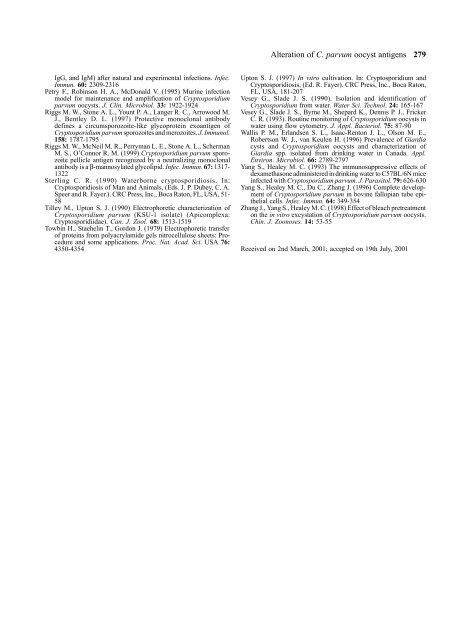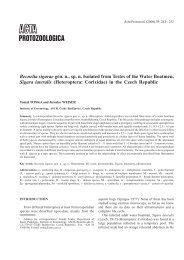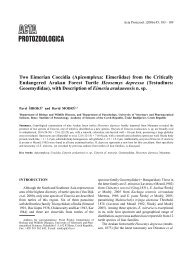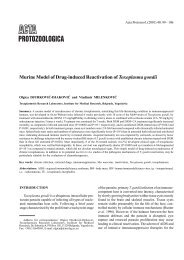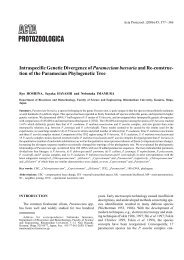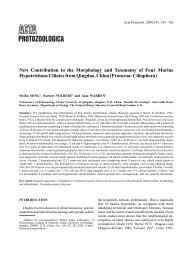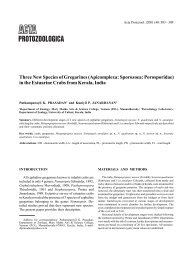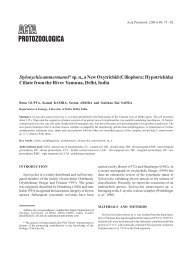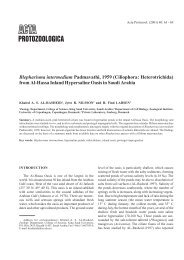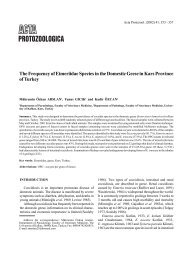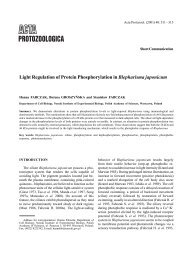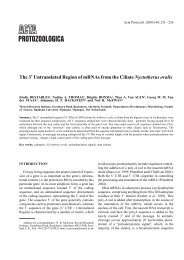278 S-F. Liao et al.antigens with molecular weights ranging from 72 kD togreater than 100 kD. Current and Garcia (1991) reportedseveral Mabs specific for C. <strong>parvum</strong> oocyst/sporozoite antigens, with molecular weights ranging fromapproximately 48 kD (Nina et al. 1992) to more than 200kD (Arrowood and Sterling 1989, Bonnin et al. 1991).However, the sensitivity <strong>of</strong> these antigens to bleachtreatment was not evaluated. In the present study, HMSrecognized 15 CPOH protein bands before and 10 bandsafter oocysts were treated with bleach, again signalingprotein sensitivity to sodium hypochlorite exposure(Fig. 3). Not surprisingly, epitopes recognized by Mabsproduced to CPOH showed variable susceptibility tobleach. Whereas Mabs 9D10, 2C5, and 8C6 reactedwith labile epitopes, the epitope recognized by Mab 6B4was clearly not sensitive to bleach treatment (Fig. 3).Moore et al. (1998) predicted that the development <strong>of</strong>antibodies targeted to antigens that were not sensitive tosodium hypochlorite treatment was unlikely. Althoughwe agree that commercially available antibodies specificfor <strong>Cryptosporidium</strong> antigens either fail to react orreact very weakly with oocysts following sodium hypochloritetreatment, Mab 6B4 from our panel recognizesan epitope that resists exposure to 20% bleach forat least 30 min, while Mab 9D10 recognizes an epitopethat does not resist such an exposure. This is particularlyrelevant for investigators studying the life cycle <strong>of</strong>C. <strong>parvum</strong> in vitro because there is a measured advantagein discriminating between oocysts used to inoculatecell culture (decontaminated with bleach) and oocystsproduced in cell culture as the parasite completes its lifecycle (not exposed to bleach) (Healey et al. 1997, Upton1997). Moreover, the water industry has a dedicatedinterest in antibodies capable <strong>of</strong> detecting C. <strong>parvum</strong>oocysts that have been exposed to various disinfectionprocedures (Campbell et al. 1982). Such proceduresfrequently reduce oocyst detection by antigenic alteration,but rarely reduce oocyst viability (Korich et al.1990).The importance <strong>of</strong> C. <strong>parvum</strong> oocyst antigenic liabilityto disinfectants, sanitizing treatments, and naturallyoccurring oxidizing conditions is uncontested from thevantage point <strong>of</strong> antibody-mediated oocyst detection.The next step will be to develop Mabs capable <strong>of</strong>specifically identifying C. <strong>parvum</strong> in samples containingdifferent species <strong>of</strong> <strong>Cryptosporidium</strong>.Acknowledgements. This research was supported in part by theUtah Agricultural Experiment Station and approved as journal paperno. 7223. The protocol for this study was approved by the UtahState University Institutional Animal Care and Use Committee.REFERENCESArrowood M. J., Sterling C. R. (1989) Comparison <strong>of</strong> conventionalstaining methods and monoclonal antibody-based methods for<strong>Cryptosporidium</strong> oocyst detection. J. Clinic. Microbiol. 27:1490-1495Bonnin A., Dubremetz J. F., Camerlynck P. (1991) Characterizationand immunolocalization <strong>of</strong> an oocyst wall antigen <strong>of</strong><strong>Cryptosporidium</strong> <strong>parvum</strong> (Protozoa: <strong>Apicomplexa</strong>). Parasitology103: 171-177Campbell I., Tzipori S., Hutchison G., Angus K. W. (1982) Effect <strong>of</strong>disinfectants on survival <strong>of</strong> <strong>Cryptosporidium</strong> oocysts. Vet. Rec.111: 414-415Current W. L., Garcia L. S. (1991) Cryptosporidiosis. Clin. Microbiol.Rev. 4: 325-358Forney J. R., Yang S., Healey M. C. (1996) Interaction <strong>of</strong> the humanserine protease inhibitor α-1-antitrypsin with <strong>Cryptosporidium</strong><strong>parvum</strong>. J. Parasitol. 82: 469-502Garcia L. S., Brewer T. C., Bruckner D. A. (1987) Fluorescencedetection <strong>of</strong> <strong>Cryptosporidium</strong> oocysts in human fecal specimensby using monoclonal antibodies. J. Clin. Microbiol. 25: 119-121Healey M. C., Yang S., Du C., Liao S-F. (1997) Bovine fallopian tubeepithelial cells, adult C57BL/6 mice, and non-neonatal pigs asmodels for cryptosporidiosis. J. Euk. Microbiol. 44: 64S-65SKilani R. T., Sekla L. (1987) Purification <strong>of</strong> <strong>Cryptosporidium</strong> <strong>parvum</strong>oocysts and sporozoites by cesium chlorite and Percoll gradients.J. Trop. Med. Hyg. 36: 505-508Korich D. G., Mead J. R., Madore M. S., Sinclair N. A., Sterling C.R. (1990) Effects <strong>of</strong> ozone, chlorine dioxide, chlorine, andmonochloramine on <strong>Cryptosporidium</strong> <strong>parvum</strong> oocyst viability.Appl. Environ. Microbiol. 56: 1423-1428Laemmli U. K. (1970) Cleavage <strong>of</strong> structural proteins during theassembly <strong>of</strong> the head <strong>of</strong> bacteriophage T4. Nature (London) 227:680-685Lazo A., Barriga O. O., Redman D. R., Bech-Nielsen S. (1986)Identification by transfer blot <strong>of</strong> antigens reactive in the enzymelinkedimmunosorbent assay (ELISA) in rabbits immunized anda calf infected with <strong>Cryptosporidium</strong> sp. Vet. Parasitol. 21: 151-163Luft B. J., Payne D., Woodmansee D., Kim C. W. (1987) Characterization<strong>of</strong> the <strong>Cryptosporidium</strong> antigens from sporulated oocysts<strong>of</strong> <strong>Cryptosporidium</strong> <strong>parvum</strong>. Infec. Immun. 55: 2436-2441Lumb R., Lanser J. A., O’Donoghue P. J. (1988) Electrophoretic andimmunoblot analysis <strong>of</strong> <strong>Cryptosporidium</strong> oocysts. Immunol. CellBiol. 66: 369-376MacKenzie W. R., Hoxie N. J., Gradus M. E., Blair K. A., PetersonD. E., Kazmierczak J. J., Addiss D. G., Fox K. R., Rose J. B.,Davis J. P. (1994) A massive outbreak in Milwaukee <strong>of</strong><strong>Cryptosporidium</strong> infection transmitted through the public watersupply. N. Engl. J. Med. 331: 161-167Madore M. S., Rose J. B., Gerba C. P., Arrowood M. J., Sterling C.R. (1987) Occurrence <strong>of</strong> <strong>Cryptosporidium</strong> oocysts in sewageeffluents and selected surface waters. J. Parasitol. 73: 702-705Moore A. G., Vesey G., Champion A., Scandizzo P., Deere D., VealD., Williams K. L. (1998) Viable <strong>Cryptosporidium</strong> <strong>parvum</strong>oocysts exposed to chlorine or other oxidizing conditions maylack identifying epitopes. Int. J. Parasitol. 28: 1205-1212Nina J. M. S., McDonald V., Deer R. M. A., Wright S. E., Dyson D.A., Chiodini P. L., McAdam K. P. W. J. (1992) Comparativestudy <strong>of</strong> the antigenic composition <strong>of</strong> oocyst isolates <strong>of</strong><strong>Cryptosporidium</strong> <strong>parvum</strong> from different hosts. Parasite Immunol.14: 227-232Peeters J. E., Mazás E. A., Masschelein W. J., Martinez de MatueanaI. V., Debacker E. (1989) Effect <strong>of</strong> disinfection <strong>of</strong> drinking waterwith ozone or chlorine dioxide on survival <strong>of</strong> <strong>Cryptosporidium</strong><strong>parvum</strong> oocysts. Appl. Environ. Microbiol. 55: 1519-1522Peeters J. E., Villacorta I., Vanopdenbosch E., Vandergheynst D.,Naciri M., Ares-Mazás E., Yvoré P. (1992) <strong>Cryptosporidium</strong><strong>parvum</strong> in calves: kinetics and immunoblot analysis <strong>of</strong> specificserum and local antibody responses (Immunoglobulin A [IgA],
<strong>Alteration</strong> <strong>of</strong> C. <strong>parvum</strong> oocyst antigens 279IgG, and IgM) after natural and experimental infections. Infec.Immun. 60: 2309-2316Petry F., Robinson H. A., McDonald V. (1995) Murine infectionmodel for maintenance and amplification <strong>of</strong> <strong>Cryptosporidium</strong><strong>parvum</strong> oocysts. J. Clin. Microbiol. 33: 1922-1924Riggs M. W., Stone A. L., Yount P. A., Langer R. C., Arrowood M.J., Bentley D. L. (1997) Protective monoclonal antibodydefines a circumsporozoite-like glycoprotein exoantigen <strong>of</strong><strong>Cryptosporidium</strong> <strong>parvum</strong> sporozoites and merozoites. J. Immunol.158: 1787-1795Riggs M. W., McNeil M. R., Perryman L. E., Stone A. L., SchermanM. S., O’Connor R. M. (1999) <strong>Cryptosporidium</strong> <strong>parvum</strong> sporozoitepellicle antigen recognized by a neutralizing monoclonalantibody is a β-mannosylated glycolipid. Infec. Immun. 67: 1317-1322Sterling C. R. (1990) Waterborne cryptosporidiosis. In:Cryptosporidiosis <strong>of</strong> Man and Animals, (Eds. J. P. Dubey, C. A.Speer and R. Fayer.). CRC Press, Inc., Boca Raton, FL, USA, 51-58Tilley M., Upton S. J. (1990) Electrophoretic characterization <strong>of</strong><strong>Cryptosporidium</strong> <strong>parvum</strong> (KSU-1 isolate) (<strong>Apicomplexa</strong>:Cryptosporidiidae). Can. J. Zool. 68: 1513-1519Towbin H., Staehelin T., Gordon J. (1979) Electrophoretic transfer<strong>of</strong> proteins from polyacrylamide gels nitrocellulose sheets: Procedureand some applications. Proc. Nat. Acad. Sci. USA 76:4350-4354Upton S. J. (1997) In vitro cultivation. In: <strong>Cryptosporidium</strong> andCryptosporidiosis, (Ed. R. Fayer). CRC Press, Inc., Boca Raton,FL, USA, 181-207Vesey G., Slade J. S. (1990). Isolation and identification <strong>of</strong><strong>Cryptosporidium</strong> from water. Water Sci. Technol. 24: 165-167Vesey G., Slade J. S., Byrne M., Shepard K., Dennis P. J., FrickerC. R. (1993). Routine monitoring <strong>of</strong> <strong>Cryptosporidium</strong> oocysts inwater using flow cytometry. J. Appl. Bacteriol. 75: 87-90Wallis P. M., Erlandsen S. L., Isaac-Renton J. L., Olson M. E.,Robertson W. J., van Keulen H. (1996) Prevalence <strong>of</strong> Giardiacysts and <strong>Cryptosporidium</strong> oocysts and characterization <strong>of</strong>Giardia spp. isolated from drinking water in Canada. Appl.Environ. Microbiol. 66: 2789-2797Yang S., Healey M. C. (1993) The immunosuppressive effects <strong>of</strong>dexamethasone administered in drinking water to C57BL/6N miceinfected with <strong>Cryptosporidium</strong> <strong>parvum</strong>. J. Parasitol. 79: 626-630Yang S., Healey M. C., Du C., Zhang J. (1996) Complete development<strong>of</strong> <strong>Cryptosporidium</strong> <strong>parvum</strong> in bovine fallopian tube epithelialcells. Infec. Immun. 64: 349-354Zhang J., Yang S., Healey M. C. (1998) Effect <strong>of</strong> bleach pretreatmenton the in vitro excystation <strong>of</strong> <strong>Cryptosporidium</strong> <strong>parvum</strong> oocysts.Chin. J. Zoonoses. 14: 53-55Received on 2nd March, 2001; accepted on 19th July, 2001


